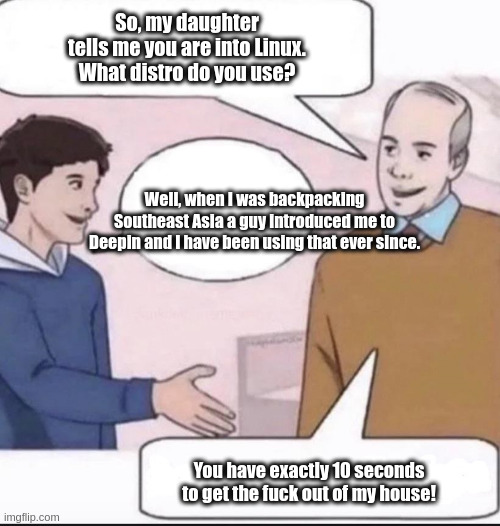this post was submitted on 12 Dec 2024
405 points (94.5% liked)
linuxmemes
21748 readers
1215 users here now
Hint: :q!
Sister communities:
Community rules (click to expand)
1. Follow the site-wide rules
- Instance-wide TOS: https://legal.lemmy.world/tos/
- Lemmy code of conduct: https://join-lemmy.org/docs/code_of_conduct.html
2. Be civil
- Understand the difference between a joke and an insult.
- Do not harrass or attack members of the community for any reason.
- Leave remarks of "peasantry" to the PCMR community. If you dislike an OS/service/application, attack the thing you dislike, not the individuals who use it. Some people may not have a choice.
- Bigotry will not be tolerated.
- These rules are somewhat loosened when the subject is a public figure. Still, do not attack their person or incite harrassment.
3. Post Linux-related content
- Including Unix and BSD.
- Non-Linux content is acceptable as long as it makes a reference to Linux. For example, the poorly made mockery of
sudoin Windows. - No porn. Even if you watch it on a Linux machine.
4. No recent reposts
- Everybody uses Arch btw, can't quit Vim, <loves/tolerates/hates> systemd, and wants to interject for a moment. You can stop now.
Please report posts and comments that break these rules!
Important: never execute code or follow advice that you don't understand or can't verify, especially here. The word of the day is credibility. This is a meme community -- even the most helpful comments might just be shitposts that can damage your system. Be aware, be smart, don't fork-bomb your computer.
founded 2 years ago
MODERATORS
you are viewing a single comment's thread
view the rest of the comments
view the rest of the comments

it's trivial to break that approach by obfuscating strings. You can do things like using base64 encoded strings in the source code, building strings from smaller component parts, or using rot13 on, say, the host component of a URI. That last one could be pretty interesting if you, as a threat actor, owned both permutations. The hostname (minus TLD) in the source code could be the nice, human readable version (www.happysite.org) that appears to be something legit. Then, when you rot13 it to www.uncclfvgr.org, traffic is sent to the evil site doing scary things. People can be far more tricksy than that. There's also the whole issue around whether or not the binaries you're running actually match the code in the repo. The xz kerfuffle showed how much can be hidden that way.
EDIT: I should make it clear that I don't use Deepin or the DE it provides because I only use WMs with no desktop, so the distro and DE are of no interest to me. I don't know if it's a security hazard or not, I have no horse in this fight.